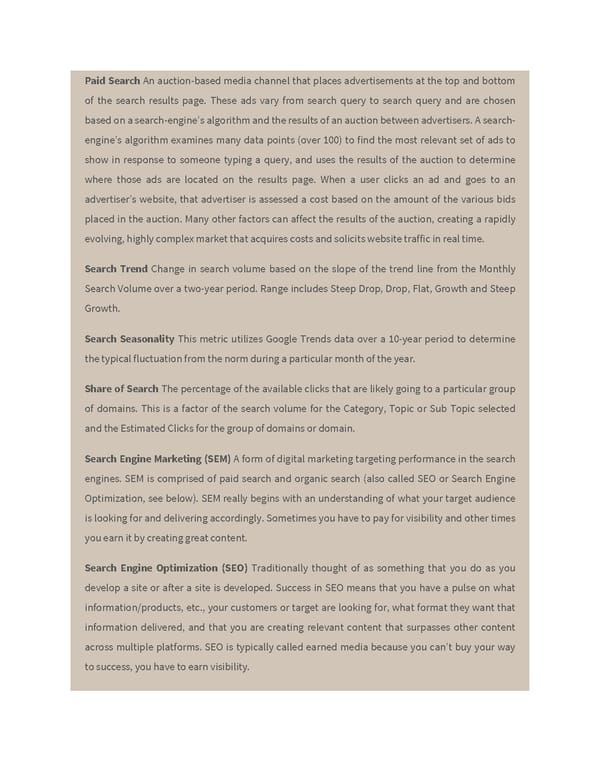Paid Search An auction-based media channel that places advertisements at the top and bottom of the search results page. These ads vary from search query to search query and are chosen based on a search-engine’s algorithm and the results of an auction between advertisers. A search- engine’s algorithm examines many data points (over 100) to find the most relevant set of ads to show in response to someone typing a query, and uses the results of the auction to determine where those ads are located on the results page. When a user clicks an ad and goes to an advertiser’s website, that advertiser is assessed a cost based on the amount of the various bids placed in the auction. Many other factors can affect the results of the auction, creating a rapidly evolving, highly complex market that acquires costs and solicits website traffic in real time. Search Trend Change in search volume based on the slope of the trend line from the Monthly Search Volume over a two-year period. Range includes Steep Drop, Drop, Flat, Growth and Steep Growth. Search Seasonality This metric utilizes Google Trends data over a 10-year period to determine the typical fluctuation from the norm during a particular month of the year. Share of Search The percentage of the available clicks that are likely going to a particular group of domains. This is a factor of the search volume for the Category, Topic or Sub Topic selected and the Estimated Clicks for the group of domains or domain. Search Engine Marketing (SEM) A form of digital marketing targeting performance in the search engines. SEM is comprised of paid search and organic search (also called SEO or Search Engine Optimization, see below). SEM really begins with an understanding of what your target audience is looking for and delivering accordingly. Sometimes you have to pay for visibility and other times you earn it by creating great content. Search Engine Optimization (SEO) Traditionally thought of as something that you do as you develop a site or after a site is developed. Success in SEO means that you have a pulse on what information/products, etc., your customers or target are looking for, what format they want that information delivered, and that you are creating relevant content that surpasses other content across multiple platforms. SEO is typically called earned media because you can’t buy your way to success, you have to earn visibility.
 Ogilvy on Advertising in the Digital Age Page 241 Page 243
Ogilvy on Advertising in the Digital Age Page 241 Page 243